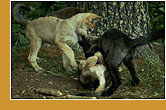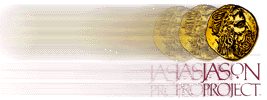Units for 7th Grade Reading
The following units are taught in
the seventh grade reading course.
Study Skills Unit (Interdisciplinary
unit taught concurrently in all content areas.)

This unit reviews basic strategies for improving
success at school. Activities include examining school
and home study habits, using organizational
materials and goal setting for the year. Strategies are reinforced across
all content areas and are
applied throughout the school year.
Materials: The Study Game, A.M.S. Assignment
Notebook
Benchmark Skills: A.1,
A.4, B.1, B.3, D.1
"Setting Goals": (Thematic unit
tied to math.)

The focus of this unit is on the importance of
looking ahead in life and setting goals. Students read biographies in which
they are introduced to people such as Jaime Escalante, a teacher
in East Los Angeles, and Anne Sullivan, Helen
Keller's mentor. In math, they view videos
called "Futures" which connect the skills they learn
in the classroom to various careers. As a
final project, students research the life of a person they admire and promote
them in a persuasive presentation. They then send letters to their role
models to ask about the importance of setting goals in their
lives.
Books: The Miracle Worker, by William
Gibson ,Stand and Deliver by Nicholas
Edwards, The View From Saturday, by E.L. Konigsburg
Benchmark Skills: A.1-3,
B.1-3, C.1, D.1, E.1, F.1
"Nature's Fury" Unit (Interdisciplinary
unit taught concurrently with science, English, and guidance.)

What happens when people are faced with the forces
of nature? How do people record their experiences with nature? These are
two of the central questions students attempt to answer in this unit. In
reading, students learn strategies for reading and understandinghistorical
fiction. In science, the emphasis is on the
scientific explanation for events such as earthquakes and volcanoes, while
in English students learn how to use research materials to find out more
about their topics. The guidancecounselors discuss the assets students
need to deal with uncontrollable events which may occur in their own lives.
The unit culminates with creating a presentation for a "living history
museum" describing eye witness accounts from historic natural disasters.
Books: Students select from fifteen
different titles.
Benchmark Skills: A.1-4,
B.1-3, C.1, D.1, E.1, F.1
See Nature's Fury Unit activities
and Wax Museum pictures.
Wolf Thematic Unit (Interdisciplinary
unit taught concurrently with geography, guidance, English and science)

Wolves have been stereotyped as evil and
vicious throughout much of human history. In this unit, students compare
information about wolves presented in informative
materials in science class with their portrayal in literature. In English
and guidance, students examine how stereotyping occurs and learn
to identify it in children's stories and fairy tales. As a final project,
students create book reviews and "adopt" a wolf by sponsoring research
through the Timberwolf Information Network.
Books: Julie of the Wolves by
Jean Craighead George ,Call of the Wild
by Jack London , Child of the Wolves, by Elizabeth Hall, Shadow
of the Wolf, by Mary Cassavera.
Benchmark Skills: A.1-4,
B.1-3, C.1, D.1, E.1, F.1
See wolf unit activities
and lesson plans.
You Can Soar - Biography Unit (Interdisciplinary
unit taught concurrently with English, science, and geography)

One of the greatest mysteries of the twentieth
century is what happened to Amelia Earhart. In this unit students
read a biography of this woman aviator and then research possible explanations
for her disappearance. In science, students
learn the basic principles of flight, and in English they develop
a personal scrapbook with writing assignments
similar to one Amelia Earhart developed as a young woman. Geography classes
trace her last flight and examine the changes in the countries since that
time. Students complete the unit by selecting a biography of their own
choise and then presenting information about it in a wax museum.
Books: Lost Star: The Story of Amelia
Earhart by Patricia Lauber ,Amelia
Earhart: Challenging the Skies by Susan Sloate
Benchmark Skills: A.1-4,
B.1, B.3, C.1, D.1, E.1, F.1
Olympics Thematic Unit (Interdisciplinary
unit taught concurrently with English and geography)

During Olympic years, the seventh grade team
looks at this world wide event . In English and guidance, students examine
the role of sports and athletes in society. In geography, they learn about
its history, events and countries which make up the world-wide
games. In reading, students follow news reports
of their favorite Olympic athletes. They learn strategies for reading charts,
graphs and statistical information from news items.
They then create a "trading card" which displays what they have learned
about an athlete in a concise and interesting way. The unit culminates
in a team wide "Olympic" competition developed by the phy ed department
and writing letters to their favorite athletes.
Materials: The Eau Claire Leader- Telegram
newspaper,
library reference materials.
Benchmark Skills: A.4,
B.1-3, D.1
Multicultural Literature Unit
(Interdisciplinary unit taught concurrently with English and geography)
In this unit, students learn about how literature
can reveal culture. In geography class, students participate in a simulatedtrip
around the world. In reading students examine versions of Cinderella tales
from many lands. Studentds select a novel which
describe the land and people of one of the countries visited. They apply
strategies to evaluate the novel and compare
it to other selections using a criteria which they develop. During the
unit students create a story cloth which tells the story of their book.
In English, students write about their own backgrounds and family history.
Books: Extensive list available from the teacher.
Benchmark Skills: A.1-3,
B.1-3, D.1, E.1

Jason Project (Interdisciplinary
unit taught concurrently with English, geography and science)
Each year AMS students join with thousands of
other students around the world to participate in the Jason
Project, a science and technology based unit of study. Directed by Dr.
Robert Ballard, the discoverer of the Titanic,
the Jason Project allows students to participate in scientific research
at locations all over the world.
Through the use of satellite communication, internet discussion and video,
students study a research topic then share
their results with scientists and other students. This interdisciplinary
unit includes a novel study, scientific
research and communication skills. It culminates in
a presentation on a topic related to the Jason
Project. Students are lead through the steps in researching and then presenting
a speech on their topic. The presentations
may then be given as part of the satellite downlink activities or for the
Science Fair.
Books: Selections are determined annually by The
Jason Project.
Benchmark Skills: A.1-4,
B.1-3, C.1, D.1, E.1, F.1
The Outsiders (Integrated
unit taught with guidance)
When sixteen year old S.E. Hinton published her
first novel The Outsiders in 1963, little did she realize that she
was creating a new kind of literature aimed at the needs of adolescent
readers. It is no wonder that this book remains
today on the top ten list of favorite books for teenagers. Set in the midwestern
town of Tulsa, Oklahoma, Hinton wrote about the divisions she saw among
her classmates based on status and wealth. Hinton urges her readers to
look beneath clothes, cars and haircuts to see the value of a person. During
this unit, guidance counselors discuss issues relating to respect for others.
For the unit project students create a children's picture book to teach
about accepting others and handling problems peacefully.
Book: The Outsiders by
S.E. Hinton
Benchmark Skills: A.1-3,
B.1-3, C.1, D.1
Back to Reading 7 Home Page
Last updated, 2003






